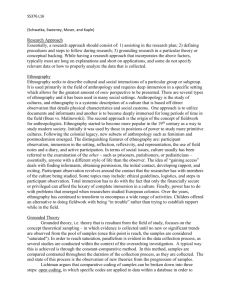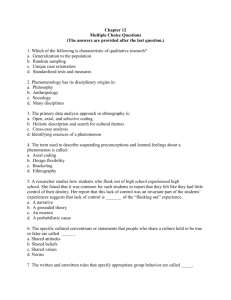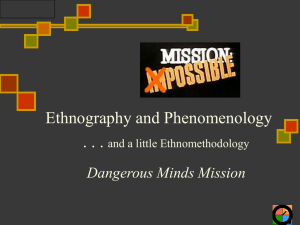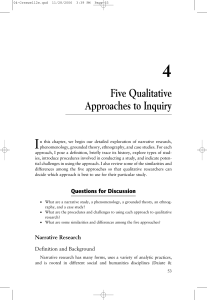Qualitative Research Designs: Ethnography, Grounded Theory
advertisement
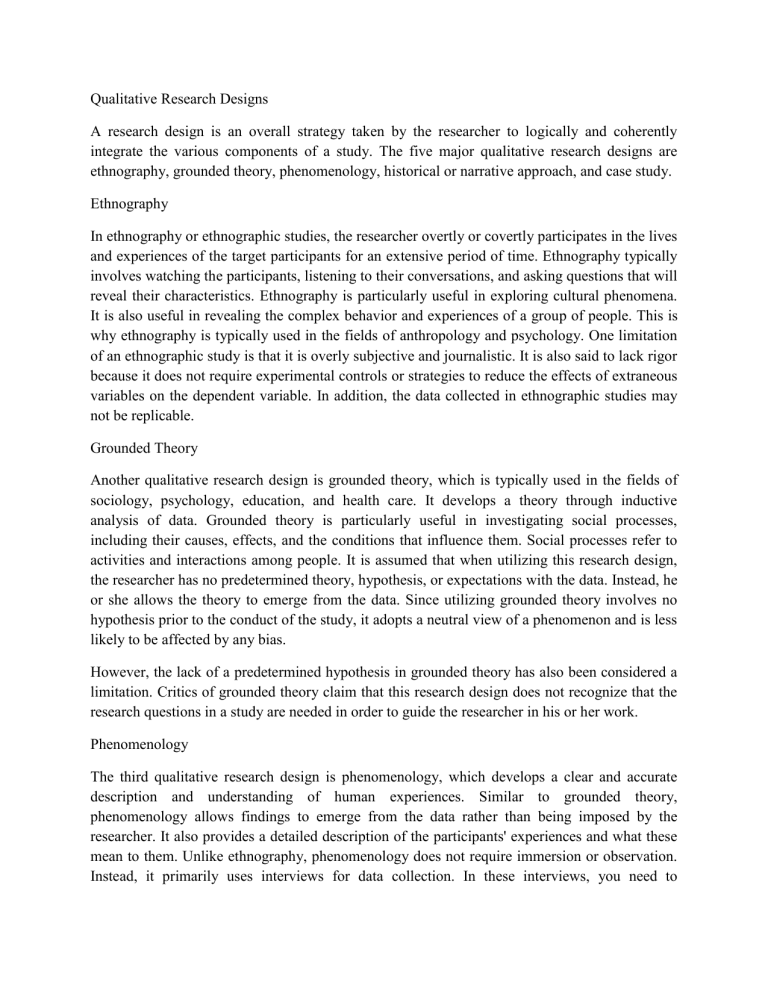
Qualitative Research Designs A research design is an overall strategy taken by the researcher to logically and coherently integrate the various components of a study. The five major qualitative research designs are ethnography, grounded theory, phenomenology, historical or narrative approach, and case study. Ethnography In ethnography or ethnographic studies, the researcher overtly or covertly participates in the lives and experiences of the target participants for an extensive period of time. Ethnography typically involves watching the participants, listening to their conversations, and asking questions that will reveal their characteristics. Ethnography is particularly useful in exploring cultural phenomena. It is also useful in revealing the complex behavior and experiences of a group of people. This is why ethnography is typically used in the fields of anthropology and psychology. One limitation of an ethnographic study is that it is overly subjective and journalistic. It is also said to lack rigor because it does not require experimental controls or strategies to reduce the effects of extraneous variables on the dependent variable. In addition, the data collected in ethnographic studies may not be replicable. Grounded Theory Another qualitative research design is grounded theory, which is typically used in the fields of sociology, psychology, education, and health care. It develops a theory through inductive analysis of data. Grounded theory is particularly useful in investigating social processes, including their causes, effects, and the conditions that influence them. Social processes refer to activities and interactions among people. It is assumed that when utilizing this research design, the researcher has no predetermined theory, hypothesis, or expectations with the data. Instead, he or she allows the theory to emerge from the data. Since utilizing grounded theory involves no hypothesis prior to the conduct of the study, it adopts a neutral view of a phenomenon and is less likely to be affected by any bias. However, the lack of a predetermined hypothesis in grounded theory has also been considered a limitation. Critics of grounded theory claim that this research design does not recognize that the research questions in a study are needed in order to guide the researcher in his or her work. Phenomenology The third qualitative research design is phenomenology, which develops a clear and accurate description and understanding of human experiences. Similar to grounded theory, phenomenology allows findings to emerge from the data rather than being imposed by the researcher. It also provides a detailed description of the participants' experiences and what these mean to them. Unlike ethnography, phenomenology does not require immersion or observation. Instead, it primarily uses interviews for data collection. In these interviews, you need to encourage the participants to fully describe their experiences and the situation. You need to learn about their emotions, the images they encounter or imagine, and their thoughts, memories, and sensations. One limitation of phenomenology is its dependence on what participants would say. The findings in phenomenology studies are highly influenced by the ability of participants to articulate their experiences. Historical or Narrative Approach The historical or narrative approach involves weaving together a series of events to form a cohesive story. This research design also reconciles past conflicts in society and highlights challenges which can be used as a basis for creating innovations. The methodology for this research design usually involves one or two individuals. The researcher conducts an in-depth interview and reviews documents for an extensive period of time. He or she then presents the data as a story with particular themes. The historical or narrative approach is frequently used in the field of social sciences, humanities, and education. One major advantage of using the historical approach is it provides a holistic picture of a phenomenon. Another advantage is that it allows the researcher to continually revisit data using a different perspective. However, of course, this research design is not without limitations. First, the historical approach is not appropriate for a large sample size due to the time it requires. Second, it is prone to the researcher's subjective impression of data. Lastly, it lacks definitive criteria for the assessment of the research. Case Study Finally, there is the case study approach which provides an in-depth description of a problem or situation. It is typically used in the fields of economics, business, social science, psychology, education, management, public administration, social work, and health care. A case study may use

